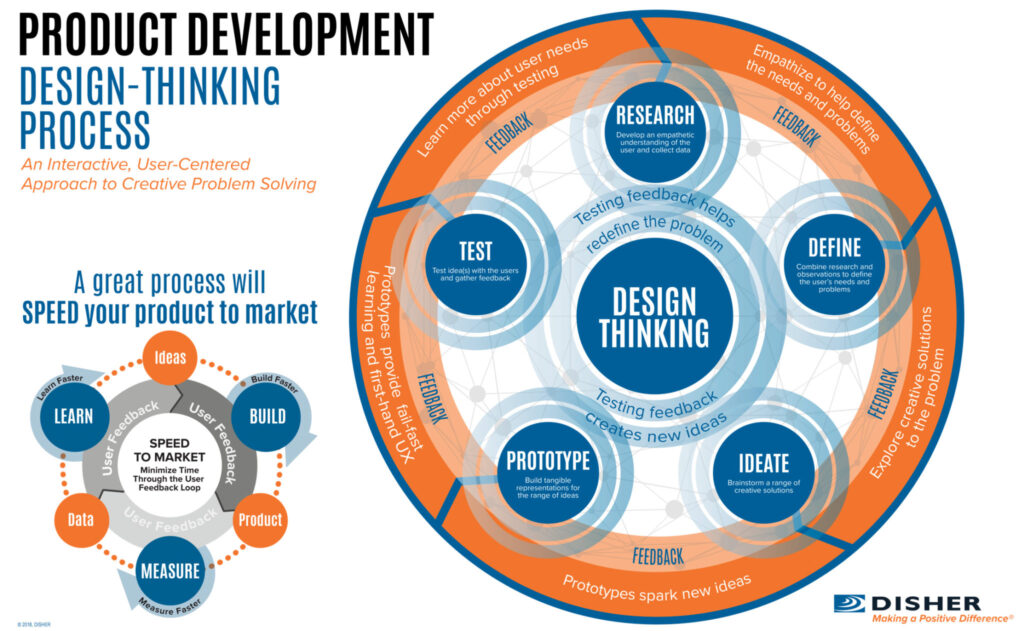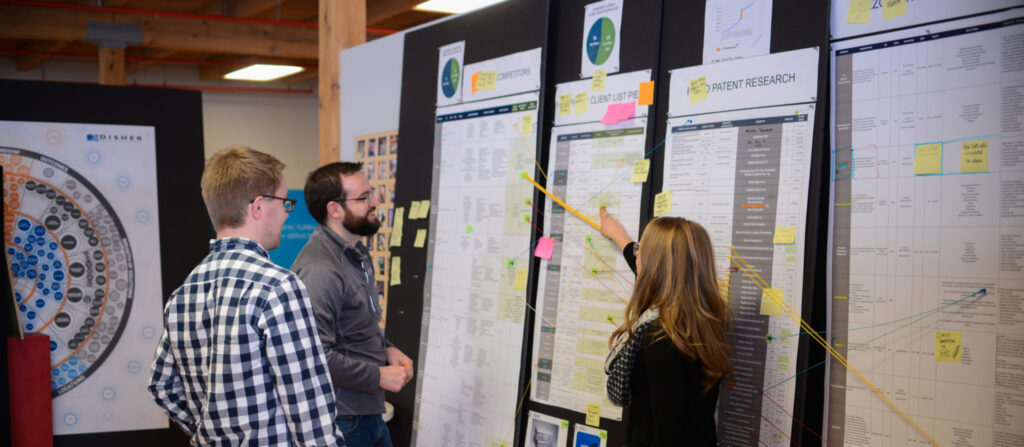
DISHER is a product development, talent solutions, and business consulting firm nationally recognized by FORTUNE and Great Place to Work as the 5th Best Small Workplace in America. DISHER’s sweet spot is helping companies efficiently develop new products by offering user-centered research, Innovation Workshops, industrial design, prototyping, and engineering. Contact DISHER to help bring your next product to market with speed, quality, and profitability.
Speed to market, or the art of transforming an idea into a product faster than anyone else, is an essential skill for new product development. Lean product development helps organizations realize revenue faster, provides a competitive edge, and increases agile responses to the demands of the market. Rollin Ford, Executive Vice President and Chief Administrative Officer of Wal-Mart agrees. “The only competitive advantage becomes the speed aspect. Organizations need to keep embracing innovation and new technology models. At the end of the day, it’s about getting from point A to point B quicker than everybody else.” This mindset keeps gaining momentum. Why? 1) The speed of innovation in today’s world is incredible, 2) The accessibility to technology and funding for individuals to develop new products (Kickstarter) means anyone can be your competition, and 3) Consumers have been conditioned for instant gratification by companies like Amazon with its two-day shipping policy.
Is faster always better? Of course not. Some use speed to market as an excuse to cut corners. This can result in the wrong product being developed or a low-quality product failing in the market. Another risk of being too quick is the potential to burn-out your team. This does not mean that slower is safer. Investing more time can be dangerous. We can be falsely comforted by the sheer amount of time we’ve invested. And when urgency is replaced by complacency in your team— be ready for failure. More development time does not always equate to a better product. Product development is a science that becomes more efficient when the right processes are successfully executed.

3 Tactics to Increase Your Speed to Market
1. FOCUS on the End Users and the Problem.
Organizations can develop products with speed, but if they aren’t focused on the right things— they may be quickly heading in the wrong direction. Efficient product development and effective product design begins with investigative research. Resist any temptation to skip this step. Research will enable your product development team to gain an empathetic understanding and real data on your target market. As W. Edwards Deming states, “Without data, you’re just another person with an opinion.” A clear understanding of the behaviors and desires of prospective and actual users will help you define their needs. Market research and benchmarking research will also give your organization a measurable and holistic perspective— and set the stage for great design.
In addition to understanding the end user, focus on defining the problem. Without a clear problem statement, time, energy, and resources can quickly be wasted solving the wrong issues. Investigative research will show possible goals, needs, and measurable criteria. It will validate the needs and problems with data and help your team prioritize, align, and move towards solving the problem in a unified way.
2. Use an Ideation FRAMEWORK.
Creating and vetting the best ideas in a systematic, collaborative way shortens the path to innovation. Quite often an organization has a handful of great ideas but they do not have the confidence to move forward on any particular one. Some companies ideate in an isolated way instead of through a community of diverse, cross-industry thinking. Innovation Workshops are an effective, structured way to collaborate, save time, and unite teams. Trained ideation facilitators guide customers through the process of colliding thoughts, expanding concepts, and selecting top ideas. Ideas are ranked in an objective way. They are ranked by a cross-functional team of subject matter experts, creative leads, and project stakeholders around three non-negotiables: user desirability, commercial viability, and production feasibility. After ranking, playbooks are created and organizations walk away with vetted ideas to act upon.
3. Get FEEDBACK Often.
Lean and agile product development utilizes feedback throughout the process. After the top ideas are vetted, it is wise to test them out through the use of rapid prototyping. Building works-like and looks-like prototypes give end users the opportunity to engage with the ideas in a tangible way. It provides quick, fail-fast learning where costs are minimal and controlled. Feedback on these models often generate new ideas. Prototyping provides valuable and timely feedback that influences a variety of things like the functionality, feel, look, manufacturability, and price of the product. Gathering feedback may seem to be an unnecessary speed bump in your design process – but in reality, it will make your product more meaningful, marketable, and makable saving time and boosting success in the long run.
By having a clear focus, a structured framework, and timely feedback in your product development process— your organization can maintain a competitive edge. Strategic tools that will help you get to market faster include investigative research, innovation workshops, and rapid prototyping. How relevant is your product development process? Continue to polish your process with tools that will not only help you survive but thrive in today’s market.


